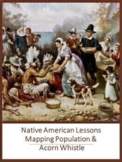Chemistry Supersaturated Solutions-Salt Sticks and Native American Food
The Lesson Pony
109 Followers
Grade Levels
6th - 8th, Homeschool
Subjects
Resource Type
Standards
NGSSMS-PS1-4
NGSSMS-PS1-1
Formats Included
- Word Document File
Pages
9 pages
The Lesson Pony
109 Followers
Also included in
- Here are fun hands-on lessons to learn about life for Native Americans. All lessons are best sellers and now they are combined for your students to get a better idea of the history and daily life of our Native American population. There is no prep but your students will love learning to make an aPrice $23.07Original Price $32.95Save $9.88
Description
Combine Chemistry and History
This lab will teach your students one of the six Native American food preservation techniques!!!
This is a terrific lab to join forces with your history department to teach the concepts of solutions, solves, solutes, and supersaturated solutions. All materials are found in the kitchen. Included are two reading one about how the Native Americans made salt sticks and the second is a science read. This is a new twist on the classic lab.
MATERIALS
Bowl
Toothpicks
Salt 2 cups
Modeling clay (non-hardening)
Cup
Measuring spoons
Boiling Hot Water
Measuring Cup
Food Coloring optional
Total Pages
9 pages
Answer Key
Included
Teaching Duration
1 Week
Report this resource to TPT
Reported resources will be reviewed by our team. Report this resource to let us know if this resource violates TPT’s content guidelines.
Standards
to see state-specific standards (only available in the US).
NGSSMS-PS1-4
Develop a model that predicts and describes changes in particle motion, temperature, and state of a pure substance when thermal energy is added or removed. Emphasis is on qualitative molecular-level models of solids, liquids, and gases to show that adding or removing thermal energy increases or decreases kinetic energy of the particles until a change of state occurs. Examples of models could include drawings and diagrams. Examples of particles could include molecules or inert atoms. Examples of pure substances could include water, carbon dioxide, and helium.
NGSSMS-PS1-1
Develop models to describe the atomic composition of simple molecules and extended structures. Emphasis is on developing models of molecules that vary in complexity. Examples of simple molecules could include ammonia and methanol. Examples of extended structures could include sodium chloride or diamonds. Examples of molecular-level models could include drawings, 3D ball and stick structures, or computer representations showing different molecules with different types of atoms. Assessment does not include valence electrons and bonding energy, discussing the ionic nature of subunits of complex structures, or a complete depiction of all individual atoms in a complex molecule or extended structure.






